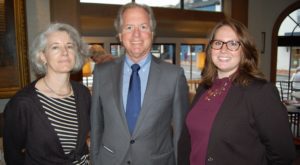Textile Museum’s Wetenhall Speaks at George Town Club
By • October 12, 2017 0 1024

“There was some angst,” admitted John Wetenhall, director of the George Washington University Museum and the Textile Museum, the speaker at Georgetown Media Group’s Oct. 12 Cultural Leadership Breakfast at the George Town Club.
Wetenhall was referring to the relocation of the Textile Museum, founded in 1925, from a pair of Kalorama mansions to a new building on the GW campus. The dual museum — designed by Hartman-Cox to incorporate historic Woodhull House, most recently a security office — opened at G and 21st Streets in March of 2015. (Last fall, Amazon CEO Jeff Bezos, who owns the Washington Post, bought the Textile Museum’s former home for $23 million.)
Appealing mainly to collectors, operating in century-old buildings that the 20,000-item collection had outgrown, the Textile Museum was in “survival mode,” said Wetenhall. Now, as part of the university’s arts build-up, and in the midst of a large, international population of students and faculty, the museum has a sound business model. In addition, a state-of-the-art storage and conservation facility was constructed on the university’s Virginia Science and Technology Campus in Ashburn.
“The context is a little broader,” he said. “Textiles as an end shifts slightly to textiles as a means.” He described programming — also at the linked George Washington University Museum, which houses the Albert H. Small Washingtoniana collection — that ties into other GW divisions and to other cultural organizations, from Georgetown’s Dumbarton Oaks and Tudor Place to the Historical Society of Washington, D.C., and the Smithsonian museums.
Wetenhall, who has a Ph.D. in art history from Stanford and an MBA from Vanderbilt, came to the museum after heading up museums in Nashville (Cheekwood), Florida (the Ringling) and Pittburgh (the Carnegie Museums). “I did a little downsizing in my career,” he said, noting that he currently supervises just 25 employees.
One thing that attracted him to GW was the university’s long-standing commitment to — and reputation in — the field of museum studies. “I wanted to be part of that pipeline that would influence the next generation of museum professionals,” he said. An associate professor as well as the museum’s director, he gave examples of ways that students were getting hands-on experience: writing labels, organizing exhibitions, even drafting policies for the university’s collections “in my class.”
Asked if the museum had changed its definition of “textile,” Wetenhall said the impression probably came from the trustees’ decision a few years back to collect contemporary fiber art. Responding to another question, he called the notion of running cultural nonprofits like for-profit businesses “stupid” and “irresponsible.” They are charities, he said, remarking that he found some organizations’ emphasis on maximizing revenue “absolutely in conflict” with their goals of diversity and access.

At the George Town Club: Frederica Adelman of the Smithsonian Associates, John Wetenhall of the George Washington Museum and the Textile Museum and GW faculty member Elizabeth Deans. Photo by Robert Devaney.

At the George Town Club: John Wetenhall, director of the George Washington University Museum and the Textile Museum. Photo by Robert Devaney.

Gertraud Hechl of Bonhams and John Wetenhall of the George Washington University Museum and the Textile Museum. Photo by Robert Devaney.

John Wetenhall of the George Washington University Museum and the Textile Museum and Mark Hudson of Tudor Place. Photo by Robert Devaney.

